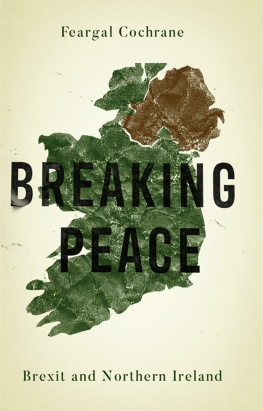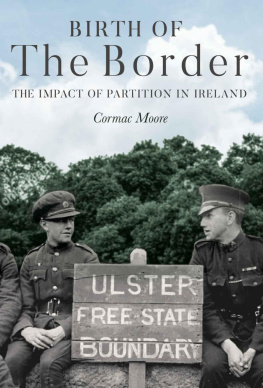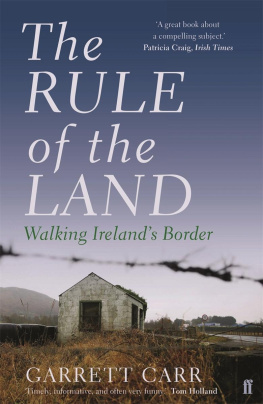PARTITIONED LIVES: THE IRISH BORDERLANDS
Heritage, Culture and Identity
Series Editor: Brian Graham,
School of Environmental Sciences, University of Ulster, UK
Other titles in this series
Irelands 1916 Rising
Explorations of History-Making, Commemoration & Heritage in Modern Times
Mark McCarthy
ISBN 978 1 4094 3623 2
Cosmopolitan Europe: A Strasbourg Self-Portrait
John Western
ISBN 978 1 4094 4371 1
Heritage from Below
Edited by Iain J.M. Robertson
ISBN 978 0 7546 7356 9
Towards World Heritage
International Origins of the Preservation Movement 18701930
Edited by Melanie Hall
ISBN 978 1 4094 0772 0
Fortifications, Post-colonialism and Power
Ruins and Imperial Legacies
Joo Sarmento
ISBN 978 1 4094 0303 6
Selling EthniCity
Urban Cultural Politics in the Americas
Edited by Olaf Kaltmeier
ISBN 978 1 4094 1037 9
Local Heritage, Global Context
Cultural Perspectives on Sense of Place
Edited by John Schofield and Rosy Szymanski
ISBN 978 0 7546 7829 8
Partitioned Lives: The Irish Borderlands
CATHERINE NASH
Queen Mary, University of London, UK
BRYONIE REID
Independent Scholar, UK
BRIAN GRAHAM
University of Ulster, UK
First published 2013 by Ashgate Publishing
Published 2016 by Routledge
2 Park Square, Milton Park, Abingdon, Oxon OX14 4RN
711 Third Avenue, New York, NY 10017, USA
Routledge is an imprint of the Taylor & Francis Group, an informa business
Copyright 2013 Catherine Nash, Bryonie Reid and Brian Graham
All rights reserved. No part of this book may be reprinted or reproduced or utilised in any form or by any electronic, mechanical, or other means, now known or hereafter invented, including photocopying and recording, or in any information storage or retrieval system, without permission in writing from the publishers.
Catherine Nash, Bryonie Reid and Brian Graham have asserted their right under the Copyright, Designs and Patents Act, 1988, to be identified as the authors of this work.
Notice:
Product or corporate names may be trademarks or registered trademarks, and are used only for identification and explanation without intent to infringe.
British Library Cataloguing in Publication Data
Nash, Catherine.
Partitioned lives : the Irish borderlands. -- (Heritage, culture and identity)
1. Borderlands--Social aspects--Ireland. 2. Northern Ireland--Boundaries--Ireland--Social aspects. 3. Ireland--Boundaries--Northern Ireland--Social aspects.
I. Title II. Series III. Graham, B. J. (Brian J.) IV. Reid, Bryonie.
304.2'3'09415-dc23
The Library of Congress has cataloged the printed edition as follows:
Nash, Catherine, author.
Partitioned lives : the Irish borderlands / by Catherine Nash, Brian Graham, and Bryonie Reid.
pages cm. -- (Heritage, culture and identity)
Includes bibliographical references and index.
ISBN 978-1-4094-6672-7 (hardback) -- ISBN 978-1-4094-6673-4 (ebook) -- ISBN 978-1-4094-6674-1 (epub) 1. Ireland--Politics and government--1922- 2. Northern Ireland--Politics and government. 3. Borderlands--Ireland. 4. Borderlands--Northern Ireland. 5. Ireland--History--Partition, 1921. 6. Historical geography. I. Title.
DA963.N34 2013
941.5082--dc23
2012047424
ISBN 9781409466727 (hbk)
ISBN 9781315599557 (ebk)
Contents
List of Figures
List of Abbreviations
ASU | Active Service Unit (IRA) |
BMPA | British Postal Museum and Archive |
GAA | Gaelic Athletic Association |
GNR | Great Northern Railway |
IRA | Irish Republican Army |
NAI | National Archive of Ireland |
PRONI | Public Record Office of Northern Ireland |
PSNI | Police Service of Northern Ireland |
RUC | Royal Ulster Constabulary |
TNA | The National Archive (UK) |
UDR | Ulster Defence Regiment |
USC | Ulster Special Constabulary |
UTV | Ulster Television |
Acknowledgements
The research for this book was funded by the Arts and Humanities Research Council (AHRC) (Grant: 18505, Irish border/lands: cultural geographies of division, interconnection and diversity). We are very grateful for this support and to the research projects advisory board for their enthusiasm and advice. Our thanks go, too, to Valerie Rose at Ashgate for her much appreciated help and encouragement with the book. We are most grateful to Dr Lorraine Dennis and Dr Amanda McMullan who were part of the research team on the project and to Ed Oliver, School of Geography, Queen Mary, University of London for his work in producing the maps in this book. Above all, however, we would like to thank all the borderlanders who so generously gave of their time, thoughts and memories during the extended interviews which are at the core of this book.
Chapter 1
Introduction
Partitioned Lives: The Irish Borderlands offers an exploration of the nature and effects of the border between Ireland and Northern Ireland from the perspectives of those who have experienced it most directly in their everyday lives. This border stemmed from the partition of Ireland in 1921 and, unsurprisingly, its subsequent meanings have been deeply entangled with the radically and often violently opposed perspectives on the legitimacy of Northern Ireland and the political reunification of the island. As a line on the map, it stands for the long and complex political and cultural history that led to partition and for the political geography of the island since then. Yet for many of those who have lived and continue to live on or near the boundary between Northern Ireland and the Irish Republic often known as borderlanders the border is not only a symbolically loaded political boundary but also a presence that impacts on everyday life as it is experienced on the ground. The border has had a material presence in borderlanders lives in myriad ways, not only through its more or less obvious existence in the landscape and its varying effects on cross-border mobility, but also through the effects of living where two political jurisdictions (or three including the wider context of the United Kingdom) with all their responsibilities and regulations, policies and procedures meet. In Partitioned Lives: The Irish Borderlands, we approach the border as lived as well as symbolic, delimited by the cartography of partition but effectively constituted through the materialities of its physical form and the objects of its regulation (from tables of custom regulations and travel permits to road blocks and military watchtowers), and through practices (from official efforts to regulate the movement of people and objects across it to the strategies and experiences of those subject to those state policies). Our focus is on the ways in which this intensely politically symbolic border has been practised, experienced and materially present in the lives and landscapes of the borderlands.












